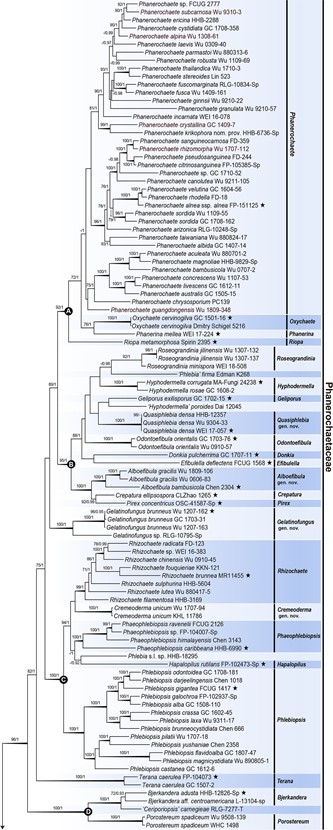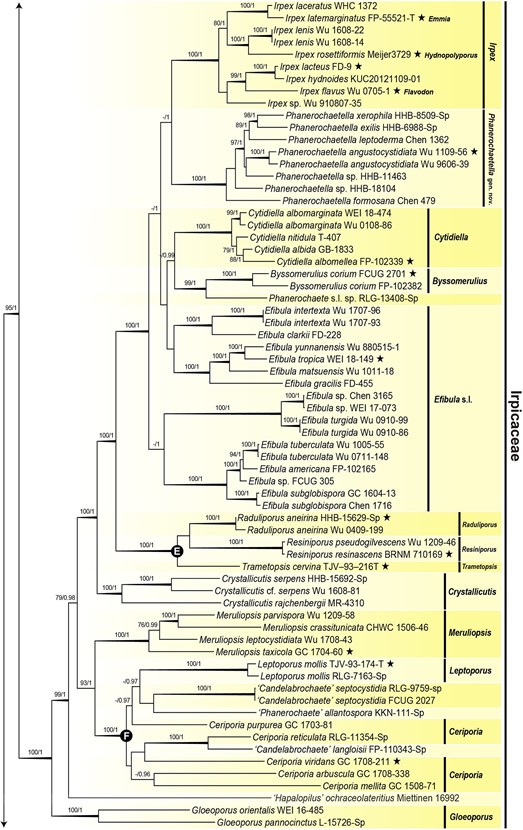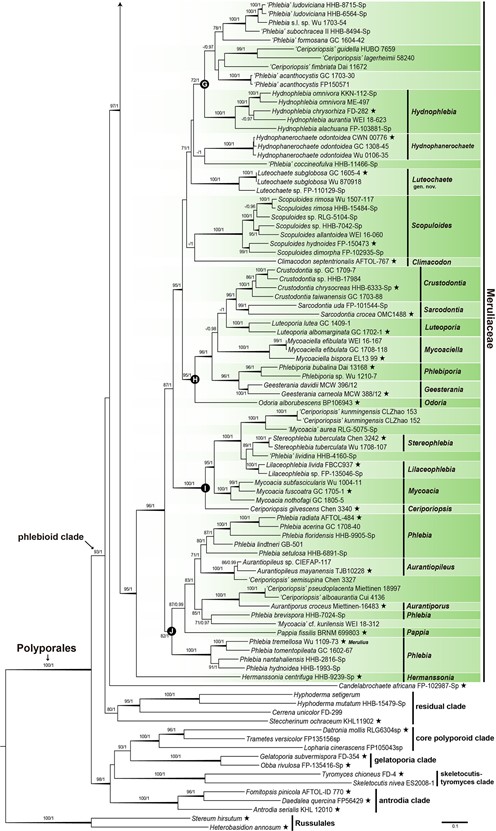Gelatinofungus Sheng H. Wu, C.C. Chen & C.L. Wei, gen. nov. Fig. 12
MycoBank number: MB 840750; Index Fungorum number: IF 840750; Facesoffungi number: FoF;
Type species: Gelatinofungus brunneus.
Etymology: From gelatino– + –fungus, referring to the gelatinous texture.
Description: Basidiocarps annual, effused, adnate, ceraceous. Hymenial surface dark purplish gray, cinnamon to brown, darkening in KOH, smooth to tuberculate. Hyphal system monomitic; generative hyphae nodose-septate. Subiculum fairly uniform, with compact texture; hyphae colorless to pale brown. Hyphidia cylindrical, thin-walled. Cystidia and cystidioles lacking. Basidia clavate, thin-walled, 4-sterigmate. Basidiospores ellipsoid to broadly ellipsoid, colorless, thin-walled, smooth, inamyloid, nondextrinoid, acyanophilous. Causing a white rot.
Notes: – In the current study, Gelatinofungus was recovered as a monophyletic group including the type species and an unnamed taxon (Fig. 1). This genus is characterized by having effused and ceraceous basidiocarps, tuberculate hymenophore, a monomitic hyphal system with clamped hyphae, subiculum and hymenial layer of compact texture, absence of cystidia, clavate basidia, and ellipsoid to broadly ellipsoid basidiospores. General morphological characteristics of this genus are reminiscent of Phlebia s.l. However, species of Phlebia s.s. usually bear cystidia and allantoid to ellipsoid basidiospores scarcely broader than 3.5 μm, and often lack hyphidia. Phlebia is presently placed in the Meruliaceae (Fig. 1).

Fig. 1 The phylogram of the phlebioid clade (Phanerochaetaceae, Irpicaceae, Meruliaceae) of Polyporales inferred from ML analyses using the combined ITS + 28S + rpb1 + rpb2 + tef1 dataset. Branches are labelled with ML BS ≥ 70% and PP ≥ 0.9 from Bayesian analyses. Thicken branches indicated both ML BS ≥ 95% and PP ≥ 0.99 from Bayesian analyses. Line- ages labeled A–J represent the Phanerochaete, Donkia, Phlebiopsis, Bjerkandera, Trametopsis, Ceriporia, Hydnophlebia, Sarcodontia, Mycoacia and core Phlebia lineages, respectively. Black stars (★) represent for strains of generic type species. Bar = substitutions per site

Fig. 1 (Continued)

Fig. 1 (Continued)

Fig. 12 Basidiocarps of Gelatinofungus brunneus (GC 1703-31, holotype) in general and detailed views. Bars = 10 mm
Species
